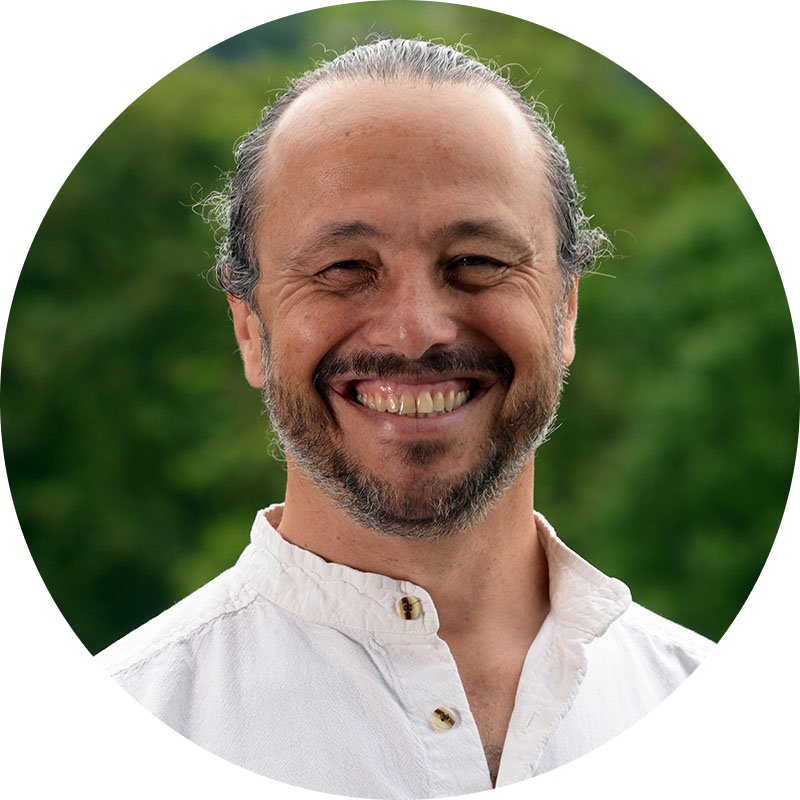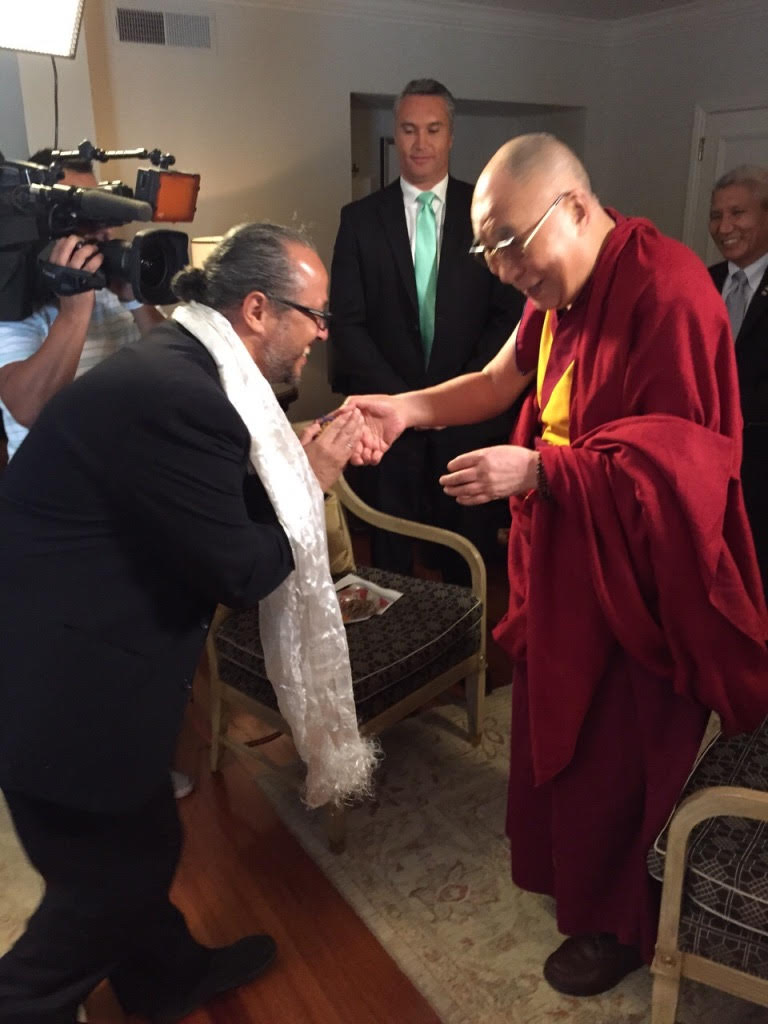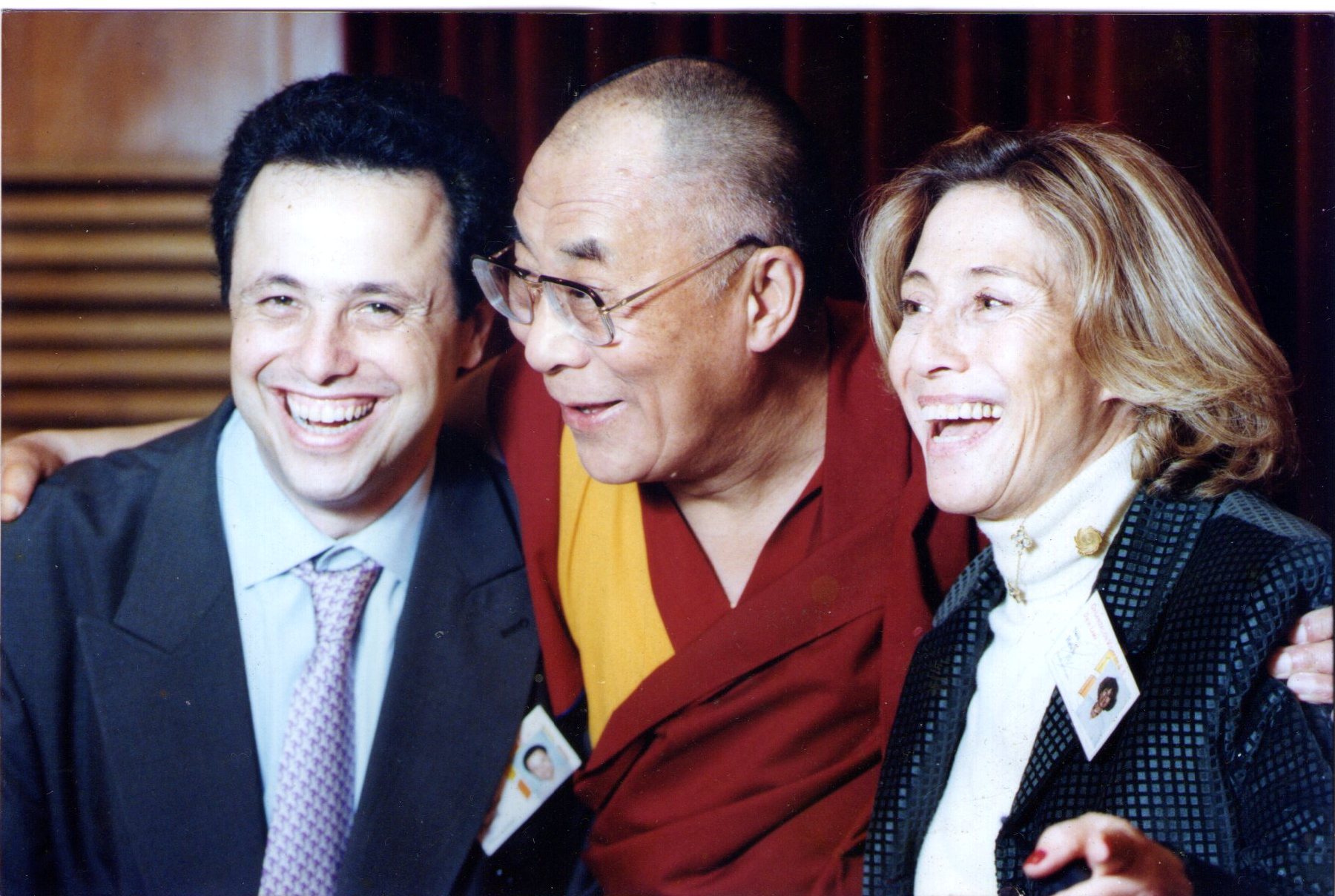Discover the “magical movements” (trul khor) of Tibetan yoga in this groundbreaking new course taught by Dr. Alejandro Chaoul. Be guided through each yogic posture and movement, while learning how to use your breath and physical body to serve the practice of meditation, and the cultivation of genuine well-being.
What You’ll Learn
- The history of Tibetan yoga in the Bon tradition
- The essential practices of trul khor or “magical movements,” the physical postures and movements of Tibetan yoga
- How trul khor relates to the profound view and practice of Dzogchen
- How the subtle body relates to meditation, and our experience of reality
- Breathing techniques to help us cultivate calmness and peace
- How to keep whatever meditation we practice fresh and inspired
- Sacred and priceless techniques to benefit our spiritual life, and bring lasting wellness into our daily life
About this Course
While yoga has been popularized in the West as a practice for physical health and well-being, the ancient practices of Tibetan yoga have often remained secretive.
Now, in this groundbreaking new Wisdom Academy course, Dr. Alejandro Chaoul explains the history of the trul khor, or magical movements, guides you through each yogic posture and movement, and teaches you to work with your body and breath to expand your meditation practice and cultivate well-being in your day-to-day life. Dr. Chaoul has spent the last thirty years studying, translating, and practicing the trul khor. Now with the blessing of contemporary masters—including the late His Holiness Lungtok Tenpai Nyima Rinpoche, His Eminence Yongdzin Lopon Tenzin Namdak Rinpoche, and Tenzin Wangyal Rinpoche—he is sharing these precious and rare teachings with you, in a format that allows them to be accessible to a modern audience.
Lessons
Lesson 1: An Introduction to Tibetan Yoga in the Bon Tradition
In this first lesson, Alejandro Chaoul introduces us to the basic concepts and history of the trul khor, or magical movements, of Tibetan Yoga. We learn trul khor’s similarities and differences with Indian hatha yoga, and how it arose in Tibet in both Buddhism and Bon—Tibet’s indigenous tradition, as well as how these practices fit into the overall path of Dzogchen (Great Perfection) teachings as a way of aligning body, energy, and mind towards mental spaciousness. He also provides an overview of the postures covered in this course and guides us through a practice that invites us to connect with our body, breath, and mind.
In this first lesson, Alejandro Chaoul introduces us to the basic concepts and history of the trul khor, or magical movements, of Tibetan Yoga. We learn trul khor’s similarities and differences with Indian hatha yoga, and how it arose in Tibet in both Buddhism and Bon—Tibet’s indigenous tradition, as well as how these practices fit into the overall path of Dzogchen (Great Perfection) teachings as a way of aligning body, energy, and mind towards mental spaciousness. He also provides an overview of the postures covered in this course and guides us through a practice that invites us to connect with our body, breath, and mind.
Lesson 2: The Nine Breathings of Purification
In this lesson, Alejandro introduces us to a central practice of Tibetan yoga: the Nine Part Breathing for Purification. We are invited to explore our inner landscape, the subtle body, through becoming aware of our channels and breath-energies—tsa and lung—and the five energy centers of the chakras. This deeper awareness helps us reflect on the Three Poisons—anger, attachment, and confusion. We then learn a breath practice intended to expel these obscurations in favor of a calm spaciousness of the mind.
In this lesson, Alejandro introduces us to a central practice of Tibetan yoga: the Nine Part Breathing for Purification. We are invited to explore our inner landscape, the subtle body, through becoming aware of our channels and breath-energies—tsa and lung—and the five energy centers of the chakras. This deeper awareness helps us reflect on the Three Poisons—anger, attachment, and confusion. We then learn a breath practice intended to expel these obscurations in favor of a calm spaciousness of the mind.
Lesson 3: The A-tri Ngondro Magical Movement
In this lesson, Alejandro introduces us to a key pose of Tibetan yoga, the ngondro of the A-tri. Ngondro, meaning “preliminary,” is a foundational, full-body magical movement intended to link mind, breath, and body in preparation for the later stages of practice. Besides providing a sense of physical centering, the ngondro is intended to infuse your practice with a pervasive sense of intent and compassion for the suffering of all sentient beings.
In this lesson, Alejandro introduces us to a key pose of Tibetan yoga, the ngondro of the A-tri. Ngondro, meaning “preliminary,” is a foundational, full-body magical movement intended to link mind, breath, and body in preparation for the later stages of practice. Besides providing a sense of physical centering, the ngondro is intended to infuse your practice with a pervasive sense of intent and compassion for the suffering of all sentient beings.
Lesson 4: The A-tri Extending the Bow to Shoot and Arrow Magical Movement
In this lesson, Alejandro introduces us a movement from the first of the five categories of postures within the A-tri, the movements for purifying the torso. Specifically, we learn the da pen zhu pen (Extending the Bow to Shoot an Arrow) magical movement. In this magical movement we connect to our heart chakra using the life force lung and are supported by the element of space to purify the torso, often related to purifying the emotion of anger.
In this lesson, Alejandro introduces us a movement from the first of the five categories of postures within the A-tri, the movements for purifying the torso. Specifically, we learn the da pen zhu pen (Extending the Bow to Shoot an Arrow) magical movement. In this magical movement we connect to our heart chakra using the life force lung and are supported by the element of space to purify the torso, often related to purifying the emotion of anger.
Lesson 5: The A-tri Bending the Neck Magical Movement
In this lesson, Alejandro introduces us to the principal movement from the second of the five categories of postures within the A-tri, the movements for purifying the head. Specifically, we learn the ke kyok (Bending the Neck) magical movement. In this magical movement we purify the head by connecting to our throat and crown chakras using the upward moving lung, and are supported by the element of earth.
In this lesson, Alejandro introduces us to the principal movement from the second of the five categories of postures within the A-tri, the movements for purifying the head. Specifically, we learn the ke kyok (Bending the Neck) magical movement. In this magical movement we purify the head by connecting to our throat and crown chakras using the upward moving lung, and are supported by the element of earth.
Lesson 6: The A-tri Throwing the Lasso Magical Movement
In this lesson, Alejandro introduces us to the principal movement from the third of the five categories of postures within the A-tri, the movements for purifying the body. Specifically, we learn the zhak pa ma (Throwing the Lasso) magical movement. In this magical movement we purify the lower body by connecting to our navel chakra using the fire-like or fire and equanimity lung, and are supported by the element of fire.
In this lesson, Alejandro introduces us to the principal movement from the third of the five categories of postures within the A-tri, the movements for purifying the body. Specifically, we learn the zhak pa ma (Throwing the Lasso) magical movement. In this magical movement we purify the lower body by connecting to our navel chakra using the fire-like or fire and equanimity lung, and are supported by the element of fire.
Lesson 7: The A-tri Extending the Four Limbs Skyward Magical Movement
In this lesson, Alejandro introduces us to the principal movement from the fourth of the five categories of postures within the A-tri, the movements for purifying the lower torso. Specifically, we learn the zhi tra ma (Extending the Four Limbs Skyward) magical movement. In this magical movement we purify the lower torso by connecting to our secret chakra using the downward-moving and clearing lung, and are supported by the element of water.
In this lesson, Alejandro introduces us to the principal movement from the fourth of the five categories of postures within the A-tri, the movements for purifying the lower torso. Specifically, we learn the zhi tra ma (Extending the Four Limbs Skyward) magical movement. In this magical movement we purify the lower torso by connecting to our secret chakra using the downward-moving and clearing lung, and are supported by the element of water.
Lesson 8: The A-tri Little Boy Jumping Strongly Magical Movement
In this lesson, Alejandro introduces us to the principal movement from the last of the five categories of postures within the A-tri, the movements for purifying the legs. Specifically, we learn the bu chung tsen chong (Little Boy Jumping Strongly) magical movement. In this magical movement we purify the legs by breathing into our central channel using pervasive breath, and are supported by the element of air.
In this lesson, Alejandro introduces us to the principal movement from the last of the five categories of postures within the A-tri, the movements for purifying the legs. Specifically, we learn the bu chung tsen chong (Little Boy Jumping Strongly) magical movement. In this magical movement we purify the legs by breathing into our central channel using pervasive breath, and are supported by the element of air.
Lesson 9: The Ngondro of the Zhang Zhung Nyan Gyud
In this lesson, Alejandro introduces us to a key pose of Tibetan yoga, the ngondro of the Zhang Zhung Nyan Gyud. This preliminary movement is a foundational, full-body movement intended to link mind, breath, and body in preparation for the later stages of practice. Besides providing a sense of physical centering, this ngondro provides a sense of clearing your entire body in one movement.
In this lesson, Alejandro introduces us to a key pose of Tibetan yoga, the ngondro of the Zhang Zhung Nyan Gyud. This preliminary movement is a foundational, full-body movement intended to link mind, breath, and body in preparation for the later stages of practice. Besides providing a sense of physical centering, this ngondro provides a sense of clearing your entire body in one movement.
Lesson 10: Integrating the Magical Movements into your Daily Practice
In this final lesson, Alejandro reviews the texts we have been learning from and discusses how to integrate the practices we have learned into your daily life. He also guides us through a practice that integrates everything we have learned in this course, and offers additional examples of how to focus on specific movements in a complete practice.
About the Teacher
 Dr. Ale Chaoul is the director of Tibetan Yoga Wellbeing, dedicated to educating individuals and communities about the ancient practice of Tibetan yoga and its transformative power to enhance physical, emotional, and spiritual well-being. He also serves as the scholar and founding
Dr. Ale Chaoul is the director of Tibetan Yoga Wellbeing, dedicated to educating individuals and communities about the ancient practice of Tibetan yoga and its transformative power to enhance physical, emotional, and spiritual well-being. He also serves as the scholar and founding
 director of the Jung Center’s Mind Body Spirit Institute (MBSI). Dr. Chaoul holds a doctoral degree in religious studies from Rice University,where his dissertation focused on the application of Tibetan yogic practices in contemporary medical settings.
For the last thirty years Ale has studied with many Tibetan teachers in India, Nepal, and the United States, including H.E. Yongdzin Tenzin Namdak and Tenzin Wangyal Rinpoche, and is an adjunct faculty member at the Integrative Medicine Program at MD Anderson Cancer Center and at The University of Texas McGovern Center for Humanities and Ethics.
director of the Jung Center’s Mind Body Spirit Institute (MBSI). Dr. Chaoul holds a doctoral degree in religious studies from Rice University,where his dissertation focused on the application of Tibetan yogic practices in contemporary medical settings.
For the last thirty years Ale has studied with many Tibetan teachers in India, Nepal, and the United States, including H.E. Yongdzin Tenzin Namdak and Tenzin Wangyal Rinpoche, and is an adjunct faculty member at the Integrative Medicine Program at MD Anderson Cancer Center and at The University of Texas McGovern Center for Humanities and Ethics.
 Since 1995, he has taught Tibetan meditation and yogic practices under the auspices of Ligmincha International across the United States, Latin America, and Europe. He is the author of Chod Practice in the Bon Tradition (Snow Lion, 2009),
Since 1995, he has taught Tibetan meditation and yogic practices under the auspices of Ligmincha International across the United States, Latin America, and Europe. He is the author of Chod Practice in the Bon Tradition (Snow Lion, 2009),
 Tibetan Yoga for Health and Wellbeing (Hay House, 2018), and Tibetan Yoga: Magical Movements of Body, Breath and Mind (Wisdom Publications, 2021). Dr. Chaoul has also been recognized as a Fellow at the Mind & Life Institute.
Tibetan Yoga for Health and Wellbeing (Hay House, 2018), and Tibetan Yoga: Magical Movements of Body, Breath and Mind (Wisdom Publications, 2021). Dr. Chaoul has also been recognized as a Fellow at the Mind & Life Institute.
Photo of Ale at lake: Volker Graf
$247.00Enroll
